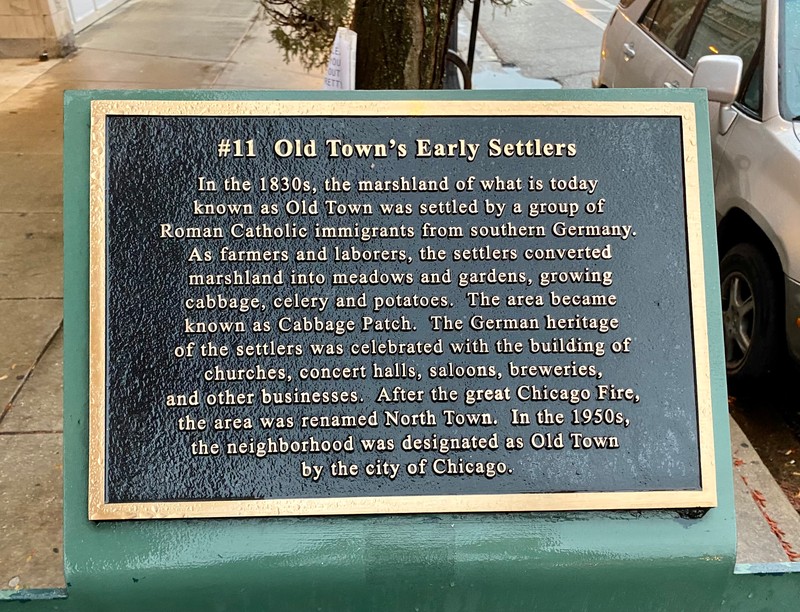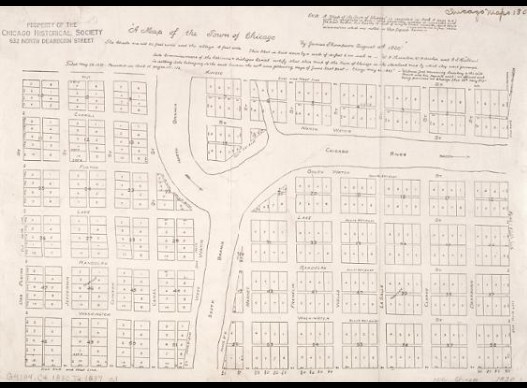Old Town's Early Settlers Historical Marker
Introduction
Text-to-speech Audio
The historic marker shares the story of Roman Catholic immigrants who arrived in what is today known as the Old Town neighborhood in the 1830s. The settlers arrived at a tiny community of only a few hundred people near Fort Dearborn (1807 - 1837) who traded with Native tribes who controlled the area around these marshy lands. The immigrants settled on swampy land but, as farmers and laborers, transformed the marshland into farmland where, by the 1840s, they grew cabbage, celery, and potatoes, lending to its nickname "Cabbage Patch." The farming success led the German immigrants to establish small businesses and breweries and build churches and other community institutions. The historic marker serves as a reminder that while the modern Old Town is part of a major metropolis abounding in concrete, it once existed as a marshy swampland inhabited by a small group of German immigrants.
Images
Old Town's Early Settlers (#11) Marker in Chicago

The Illinois and Michigan Canal Commissioners hired surveyor James Thompson to create Chicago's first plat in 1830.

Backstory and Context
Text-to-speech Audio
Although German immigration slowed dramatically from the 1770s to 1820s due to wars in both Europe and America, a renewed surge in immigration resulted in a tenfold increase in German immigration by 1830. Once Germans settled into their new American homes, they routinely wrote letters to their families and friends in Germany expressing the opportunities available in the United States, which German newspapers and books circulated, inspiring "chain migrations." As a result, the number of Germans emigrating to the U.S. by 1832 exceeded 10,000.
German immigration to Chicago arose at roughly the same time as the area, known as Chigagou ("wild garlic place") by local Native Americans, began transforming from a swampy western outpost and home to Fort Dearborn into an Anglo-American style town. The transition started in the 1820s when the U.S. Congress approved a land grant to Illinois for constructing a canal that would ultimately connect Lake Michigan to the Mississippi River via the rivers moving through modern-day Chicago. In 1830 the Illinois and Michigan Canal Commissioners hired a surveyor to create Chicago's first plat. By the early 1830s, German immigrants, mainly Roman Catholics from the southern German states, began arriving in North Town (today's Old Town neighborhood), located just north of Chicago's city limits until the city annexed the area in 1851.
The earliest German-speaking immigrants in North Town were mainly farmers and semi-skilled workers. They managed to turn Chicago's swampy soils into farming land where they kept cows and chickens and grew celery, potatoes, and cabbage. News of their farming success inspired more German immigrants to come, eventually forming a well-established German enclave, demonstrated by the construction of St. Joseph's Catholic Church in 1846. By the 1850s, the enclave supported shopkeepers, breweries, newspapers, schools, and more, bolstered by a new wave of German immigrants that fled Germany after the unrest associated with the 1848 German Revolution.
Indeed, by the 1850s, the influx of Germans coincided with Chicago's enormous population growth. Germans comprised one-sixth of Chicago's entire population in 1850, which climbed to one-fourth by 1900 when the total population reached 1.7 million. However, by 1900, North Town no longer served as the epicenter of German culture as Chicago's German populace spread throughout the city and varied by religion, generation, class, gender, and political leanings.
Sources
Brosnan, Kathleen A., Ann Durkin Keating, and William C. Barnett, eds. City of Lake and Prairie: Chicago's Environmental History. University of Pittsburgh Press, 2020.
Commission on Chicago Landmarks. "Old Town Triangle District." Chicago Department of Planning and Development. 1995. https://www.chicago.gov/content/dam/city/depts/zlup/Historic_Preservation/Agendas/Old%20Town%20Triangle%20District_Designation%20Report.pdf.
Cronon, William. Nature's Metropolis: Chicago and the Great West. New York: W. W. Norton & Company, 1991.
Harzig, Christiane. "Germans." The Electronic Encyclopedia of Chicago. 2005. http://www.encyclopedia.chicagohistory.org/pages/512.html.
"Immigration and Relocation in U.S. History: A New Surge of Growth." Library of Congress. Accessed August 12, 2023. https://www.loc.gov/classroom-materials/immigration/german/new-surge-of-growth/#:~:text=Wars%20in%20Europe%20and%20America,United%20States%20as%20their%20destination.
Ruppenstein, Andrew. "Old Town's Early Settlers (#11)." The Historical Marker Database. January 30, 2023. https://www.hmdb.org/m.asp?m=188253.
Salzmann, Joshua. "How Chicago Transformed From a Midwestern Outpost Town to a Towering City." Smithsonian Magazine. October 12, 2018. https://www.smithsonianmag.com/history/how-chicago-transformed-from-midwestern-outpost-town-to-towering-city-180970526/.
Sperber, Jonathan. "Festivals of National Unity in the German Revolution of 1848-1849." Past & Present, no. 136 (1992): 114–38.
Photographed By Andrew Ruppenstein, December 5, 2021. https://www.hmdb.org/m.asp?m=188253
http://www.encyclopedia.chicagohistory.org/pages/11175.html
